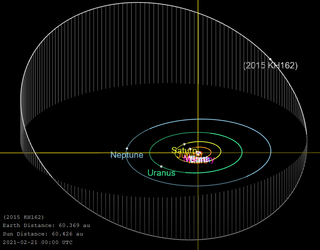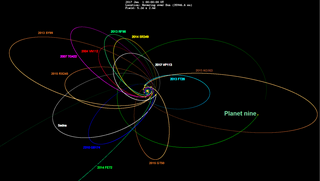Related Research Articles
(20161) 1996 TR66 is a trans-Neptunian object orbiting beyond Pluto in the Kuiper belt of the outermost Solar System, approximately 139 kilometers (86 miles) in diameter. It was discovered on 8 October 1996, by astronomers David Jewitt, Chad Trujillo, Jane Luu, and Jun Chen at the Mauna Kea Observatory, Hawaii, in the United States. It was the first discovery of a twotino.
(118228) 1996 TQ66, prov. designation:1996 TQ66, is a resonant trans-Neptunian object of the plutino population in the Kuiper belt, located in the outermost region of the Solar System. It was discovered on 8 October 1996, by American astronomers Jun Chen, David Jewitt, Chad Trujillo and Jane Luu, using the UH88 telescope at the Mauna Kea Observatories, Hawaii. The very red object measures approximately 185 kilometers (110 miles) in diameter. As of 2021, it has not been named.
(523731) 2014 OK394, also known as 1995 SN55, is a trans-Neptunian object that orbits in the outer Solar System beyond the orbit of Neptune. First observed as 1995 SN55 by Spacewatch on 20 September 1995, it was a lost minor planet with an insufficiently defined orbit with only 36 days of observations. On 8 October 2010, it was rediscovered by the Pan-STARRS 1 survey and later announced as 2014 OK394 in July 2016. It was not until November 2020 when amateur astronomers S. Deen and K. Ly identified 2014 OK394 and 1995 SN55 as the same object. This identification was confirmed and announced by the Minor Planet Center in January 2021.

(612584) 2003 QX113 is a large trans-Neptunian object from the scattered disc located in the outermost region of the Solar System. It is one of the most distant objects from the Sun at 60.5 AU. It was discovered by astronomers with the Canada–France Ecliptic Plane Survey at Mauna Kea Observatories, Hawaii, when it was near aphelion on 31 August 2003. It was provisionally designated 2003 QX113.
2004 KV18 is an eccentric Neptune trojan trailing Neptune's orbit in the outer Solar System, approximately 70 kilometers in diameter. It was first observed on 24 May 2004, by astronomers at the Mauna Kea Observatories on Hawaii, United States. It was the eighth Neptune trojan identified and the second in Neptune's L5 Lagrangian point.
1999 TR11, is a resonant trans-Neptunian object from the Kuiper belt, located in the outermost region of the Solar System. The reddish plutino measures approximately 93 kilometers (58 miles) in diameter. It was first observed on 9 October 1999, by American astronomer Scott Sheppard at the Mauna Kea Observatories with the University of Hawaii's 2.2-meter telescope.

2015 KH162 is a large trans-Neptunian object orbiting in the scattered disc region of the outermost Solar System. First observed in 2015, this minor planet is one of the most distant objects from the Sun at 60.6 AU, or twice as far as Neptune.

(523794) 2015 RR245, provisional designation 2015 RR245, is a large trans-Neptunian object of the Kuiper belt in the outermost regions of the Solar System. It was discovered on 9 September 2015, by the Outer Solar System Origins Survey at Mauna Kea Observatories on the Big island of Hawaii, in the United States. The object is in a rare 2:9 resonance with Neptune and measures approximately 600 kilometers in diameter. 2015 RR245 was suspected to have a satellite according to a study announced by Noyelles et al. in a European Planetary Science Congress meeting in 2019.

2015 RX245 is an extreme trans-Neptunian object, detached, on a highly eccentric orbit in the outermost region of the Solar System. It measures approximately 250 kilometers (160 miles) in diameter and is "possibly" a dwarf planet. It was first observed on 8 September 2015, by astronomers with Outer Solar System Origins Survey using the 3.6-meter Canada–France–Hawaii Telescope at Mauna Kea Observatories, Hawaii, in the United States.

2015 KG163, also known as o5m52, is a trans-Neptunian object from the outermost region of the Solar System, approximately 102 kilometers (63 miles) in diameter. It was first observed on 24 May 2015, by astronomers of the Outer Solar System Origins Survey using the Canada–France–Hawaii Telescope at Mauna Kea Observatories, Hawaii, United States. With an observation arc of 2 years, it passed perihelion around August 2022 at a velocity of 6.5 km/s with respect to the Sun.
2015 KH163, is a trans-Neptunian- and scattered disc object from the outermost region of the Solar System, approximately 117 kilometers in diameter. It was first observed by astronomers during the Outer Solar System Origins Survey at the Mauna Kea Observatories on 24 May 2015.
2015 KE172, internal designation o5m72, is a distant resonant trans-Neptunian object on an eccentric orbit in the outermost region of the Solar System, approximately 100 kilometers (60 miles) in diameter. It was first observed on 21 May 2015 by astronomers with the Outer Solar System Origins Survey at the Mauna Kea Observatories on the island of Hawaii, United States. It came to perihelion (closest approach to the Sun) in October 2017 at a distance of 44.1 AU (6.60 billion km). Its existence was first released in February 2018, and the observations and orbit were announced on 27 April 2018. It belongs to the most distant resonant objects known to exist.
(505448) 2013 SA100, provisional designation 2013 SA100 and also known as o3l79, is a trans-Neptunian object from the classical Kuiper belt in the outermost region of the Solar System. It was discovered on 5 August 2013, by astronomer with the Outer Solar System Origins Survey at the Mauna Kea Observatories, Hawaii, in the United States. The classical Kuiper belt object belongs to the hot population and is a weak dwarf planet candidate, approximately 260 kilometers (160 miles) in diameter.
(495603) 2015 AM281, provisional designation 2015 AM281, is a resonant trans-Neptunian object in the outermost region of the Solar System, guesstimated at approximately 470 kilometers (290 miles) in diameter. It was discovered on 13 March 2010, by astronomers with the Pan-STARRS survey at Haleakala Observatory, Hawaii, United States.
2015 FG415 is a trans-Neptunian object from the scattered disc, located in the outermost region of the Solar System. It was discovered on 17 March 2015, by American astronomer Scott Sheppard at the Mauna Kea Observatories, Hawaii, and received the provisional designation 2015 FG415. As of 2021, it is the 9th-most-distant object from the Sun at 87.2 AU and measures approximately 280 kilometers (170 miles) in diameter.
2014 UE228 is a trans-Neptunian object from the outermost region of the Solar System. The object is in a rare 3:8 resonance with Neptune and measures approximately 93 kilometers (58 miles) in diameter. It was first observed on 22 October 2014, by astronomers with the Outer Solar System Origins Survey at the Mauna Kea Observatories, Hawaii, and was provisionally designated 2014 UE228. As of 2021, it has not been numbered.
2021 DR15 is a large trans-Neptunian object in the scattered disc, around 700 kilometres (430 miles) in diameter. It was discovered on 17 February 2021, by American astronomers Scott Sheppard, David Tholen, and Chad Trujillo using the 8.2-meter Subaru Telescope of the Mauna Kea Observatories in Hawaii, and announced on 17 December 2021. It was 89.4 astronomical units from the Sun when it was discovered, making it one of the most distant known Solar System objects from the Sun as of December 2021. It has been identified in several precovery images as far back as 10 March 2005.
2019 EU5 is an extreme trans-Neptunian object from the scattered disc on a highly eccentric orbit in the outermost region of the Solar System. It was discovered on 5 March 2019, by American astronomers Scott Sheppard, David Tholen, and Chad Trujillo at Mauna Kea Observatories in Hawaii, and announced on 17 December 2021. It was 83.4 astronomical units from the Sun when it was discovered, making it one of the most distant known Solar System objects from the Sun as of December 2021. It has been identified in precovery images from 6 January 2016.
2020 BE102 is a trans-Neptunian object in the scattered disc, around 350 kilometres (220 miles) in diameter. It was discovered on 24 January 2020, by American astronomers Scott Sheppard, David Tholen, and Chad Trujillo using the 8.2-meter Subaru Telescope of the Mauna Kea Observatories in Hawaii, and announced on 31 May 2021. It was 111.2 astronomical units from the Sun when it was discovered, making it the third-farthest known Solar System object from the Sun as of May 2022, after 2018 VG18 (124 AU) and 2018 AG37 (~132 AU).
2021 RR205 is an extreme trans-Neptunian object and sednoid discovered by astronomers Scott Sheppard, David Tholen, and Chad Trujillo with the Subaru Telescope at Mauna Kea Observatory on 5 September 2021. It resides beyond the outer extent of the Kuiper belt on a distant and highly eccentric orbit detached from Neptune's gravitational influence, with a large perihelion distance of 55.5 astronomical units (AU). Its large orbital semi-major axis (~1,000 AU) suggests it is potentially from the inner Oort cloud. Like 2013 SY99, 2021 RR205 lies in the 50–75 AU perihelion gap that separates the detached objects from the more distant sednoids; dynamical studies indicate that such objects in the inner edge this gap weakly experience "diffusion", or inward orbital migration due to minuscule perturbations by Neptune.
References
- 1 2 3 "1993 RP". Minor Planet Center. International Astronomical Union. Retrieved 14 August 2023.
- 1 2 3 4 "JPL Small-Body Database Browser: (2021 RR205)" (2016-11-02 last obs.). Jet Propulsion Laboratory . Retrieved 14 August 2023.
- ↑ "JPL Horizons On-Line Ephemeris for 1993 RP at epoch JD 2460000.5". JPL Horizons On-Line Ephemeris System . Jet Propulsion Laboratory. Retrieved 21 September 2022. Solution using the Solar System Barycenter. Ephemeris Type: Elements and Center: @0)
- ↑ "Asteroid Size Estimator". Center for Near Earth Object Studies. Jet Propulsion Laboratory. Retrieved 14 August 2023.
- 1 2 "MPEC 2023-P80 : 1993 RP = 2015 VR202". Minor Planet Electronic Circular. Minor Planet Center. 14 August 2023. Retrieved 14 August 2023.
- ↑ "MPEC 2021-J131 : 2015 VR202". Minor Planet Electronic Circular. Minor Planet Center. 10 May 2021. Retrieved 14 August 2023.